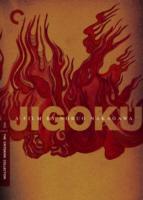 |
|

|
There is a moment that stands out in my childhood: reading the letters page of Famous Monsters magazine, and finding a description of a Japanese movie called Jigoku, or "Hell". It described how American horror movies just plain lacked, since Jigoku included scenes of people being sawed in half and boiled in lava - basically, what went on in the title location. I filed this name away in my youthful memory as something to find when I was rich and famous, as after all... what were the chances of such a thing ever getting released in America? Enter the Criterion Collection, long may they reign. Director Nobuo Nakagawa made nearly 100 movies in his time, many for the scorned Shintoho Studios. After his highly successful Ghost Story of Yotsuya came this, likely his most famous film. Like many Western directors primarily thought of as "exploitation" moviemakers, Nakagawa is experiencing a posthumous renaissance in his native land. Jigoku does not, as my youthful imagination conjectured, take place entirely in Hell; the first hour tells the story of Shiro, a university student whose luck is taking a hideous turn toward the bad. Haunted by a dark alter-ego character, Shiro finds himself implicated in the hit-and-run death of a minor Yakuza gang leader; on his way to confess to the police, his fiancee is killed in a car wreck. Multiple potboiler plotlines converge at the end of the initial hour with a welter of accidental deaths and murder, causing everyone in the cast to wind up in Hell. Though there are the expected gore moments, for the most part the Lords of Hell are much more subtle, and find psychological torment much more effective. Yes, people are sawn in half, flayed alive and dipped in catsup, but there is a much more horrifying fate in store for poor Shiro: discovering his fiancee died pregnant, he will spend eternity trying to rescue the spirit of his unborn daughter, perpetually out his reach, continually crying for his succor. That is horror. That is the stuff that stays with you.
Criterion editions are never less than breathtaking, and Jigoku is certainly no exception, boasting a "restored high-definition digital transfer". That phrase - or many like it - have been bandied about before, but this transfer is stunning. Jet blacks make the colors pop as if the movie were shot yesterday. The easy-to-read English subtitles are removable, if you want the same experience I had when I finally tracked down a copy of this movie in the 90s. Hint: It's better with the subtitles.
Building the Inferno is a new featurette containing interviews with contemporary Japanese filmmakers, Nakagawa collaborators, screenwriter Ichiro Miyagawa and actor Yoichi Numata, who played Tamura, the alter ego. At 40 minutes, it manages only a slight sketch of the filmmaker, but some scenes from his earlier Ghost Story of Yotsuya are appreciated. There is also a theatrical trailer and a gallery of gloriously cluttered posters for Nakagawa features and some of the more expoitable Shintoho features, like The Military Policeman and the Dismembered Beauty, Girl Divers of Spook Mansion or Dark Breasts. An informative pack-in booklet by Chuck Stephens rounds out the package. Jigoku proves that Nakagawa's re-appraisal is very much deserved; though nearly half a century old, the movie feels very modern, from the jarring sound collage opening titles to what was -at the time - shocking gore effects. Any Criterion disc is worth viewing for the serious film fan; for horror mavens, this is well worth at least a rental. Dr. Freex, 1/31/2007 |
|
|
|
|

